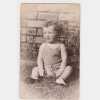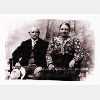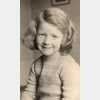| Profile | Posted by | Options | Post Date |

|
lexi
|
Report
|
17 Jan 2009 19:07 |
|
hi anne,
thanks so much for that.its very interesting to read about your surnames histories.
my dad has often joked he is related to general montgomery!!!
thanks again.
|

|
AnnCardiff
|
Report
|
17 Jan 2009 17:34 |
|
The surname of MONTGOMERY is of French origin, the medieval Hiberno-Norman families of the name in Cork are probably now extinct. The well-known families of Ulster are of 17th century introduction. It was a territorial origin from the ancient castle of Saint-Foi-de-Montgomery in the diocese of Lisieux in Normandy. The first of the name recorded in Scotland appears to have been Roger de Montgomery (died 1094) who was a Norman nobleman who took part in planning the invasion of England in 1066, but remained in Normandy as regent. The following year, however, he was summoned to England by William, being created Earl of Arundel and granted the castle of Arundel with vast estates in Sussex. Later he also received the earldom of Shrewsbury. His father, Roger de Montgomery, was seigneur of St. Germain-de-Montgomery in Calvados. It is also the name of a Scottish family who were granted the earldom of Eglinton in 1506. They are descended from a certain Robert de Montgomerie, who was granted lands by Walter, High Steward of Scotland, in the latter half of the 12th century. Through his relationship with the Seton family, the 13th Earl, Archibald Montgomery (born 1812) also became Earl of Winton in 1859. A branch of the Scottish family was established in Donegal, Ireland in 1628. A descendant of this branch (born in Australia) was Field Marshall Bernard Montgomery (1887-1976) created Viscount Montgomery of Alamein. The first people in Scotland to acquire fixed surnames were the nobles and great landowners, who called themselves, or were called by others, after the lands they possessed. Surnames originating in this way are known as territorial. Formerly lords of baronies and regalities and farmers were inclined to magnify their importance and to sign letters and documents with the names of their baronies and farms instead of their Christian names and surnames. The abuse of this style of speech and writing was carried so far that an Act was passed in the Scots parliament in 1672 forbidding the practice and declaring that it was allowed only to noblemen and bishops to subscribe by their titles.
|

|
AnnCardiff
|
Report
|
17 Jan 2009 17:32 |
|
Surname: Clements
This very interesting surname is of Old French origin, and is thought to have been introduced into England by the Normans after the Conquest of 1066. It derives from the male given name 'Clement', itself adopted from the Latin 'Clemens', and meaning 'merciful'. The original popularity in England from the mid 12th Century on, was due to the (re-discovered) fame of St. Clement, a disciple of St. Paul, and because a number of popes selected the name Clement for its symbolic values. Early examples of the personal name recordings include 'Clemens' in 1153, in the Records of St. Benets Abbey, Norfolk, and 'Clemens filius Clementis', in the Curia Regis rolls for Essex in the year 1212. William Clement as a surname is recorded in the 1275 Hundred Rolls of Norfolk, whilst Richard Clemence is listed in the Huntingdonshire Hundred Rolls of 1279. The many spellings of 'Clement' showing its great medieval popularity, range from Clem, Clemas, Clemes, Clements, Clemon(t)s, Clemetts and Clem(m)ens, to Clemence, Climance, Clemen(t)son and Clemerson, and the Cornish Clemo, Clemow, Climo, Clymo, and many others. Amongst the interesting recordings associated with the surname are Thomas Clements who was one of the early emigrants to the American Colonies, leaving London on the "Abraham" in October 1635, bound for Virginia. The coat of arms was granted in Plymouth in 1620. This has the blazon of a silver field, two red bends wavy, and on a red chief, three gold estoiles. The crest is a gold griffin on a green mount. The first recorded spelling of the family name is shown to be that of Robertus Clemens, which was dated 1155, in the Knight Templars rolls of Oxfordshire, during the reign of King Henry 11, known as "The Builder of Churches", 1154 - 1189. Surnames became necessary when governments introduced personal taxation. In England this was known as Poll Tax. Throughout the centuries, surnames in every country have continued to "develop" often leading to astonishing variants of the original spelling.
|

|
AnnCardiff
|
Report
|
17 Jan 2009 17:31 |
|
Dundalk Civil Registration District, Counties Armagh, Louth ...
Name & Surname. Year. Quarter. Alice Hoey Anne Hoey Annie Teresa Hoey Bridget Hoey Bridget Hoey Bridget Hoey Catherine Hoey Catherine Hoey Edward Hoey ...
www.from-ireland.net/extrs/d/dundalkbirths1.htm - 47k - Similar pages
|

|
AnnCardiff
|
Report
|
17 Jan 2009 17:29 |
|
Hoey Name Meaning and History
Irish: Anglicized form of Gaelic Ó hEochaidh ‘descendant of Eochaidh’, a variant of Eachaidh (see Haughey).
Norwegian: habitational name from a farmstead named Hoøy from Old Norse hór ‘high’ + ey ‘island’.
|

|
AnnCardiff
|
Report
|
17 Jan 2009 17:25 |
|
Irish genealogy - Search for your ancestor and hibernian roo...
the chance to trace their Irish family tree and search for their surname origins and the records of ... Gladney, No postings yet, Add information to Gladney ...
www.irishabroad.com/Genealogy/SurnameInfo/Surnam... - 53k - Similar pages
http://www.irishabroad.com/Genealogy/SurnameInfo/SurnameInformation_search.asp?Letter=G
|

|
AnnCardiff
|
Report
|
17 Jan 2009 17:22 |
|
Emigrants from Counties Wexford and Carlow, Ireland (c. 1000...
If you wish, I could add your e-mail and address to my web site. There may be others researching the Gladney surname. Just let me know. ... Al Lewis ...
www.bytown.net/wexlist.htm - 12k - Similar pages
http://www.bytown.net/wexlist.htm
Farnworth - Family History, Genealogy, Surnames and Local Hi...
Lancashire UK - Genealogy, Surnames, Family and Local History ... Is anyone looking for the Gladney families, originally from Counties Wexford and Carlow in ...
www.curiousfox.com/history/lancashire_32.html - 60k - Similar pages
|

|
Alison
|
Report
|
17 Jan 2009 17:20 |
|
Thanks
The name I have is HOEY
Alison
|

|
lexi
|
Report
|
17 Jan 2009 16:53 |
|
i have 2 names,
MONTGOMERY & CLEMENTS
thanks.x
|

|
Frances
|
Report
|
17 Jan 2009 15:27 |
|
Hi Ann,
Thank you for your kind offer. GLADNEY is the name which interests me and a letter from 1922 suggests that the Gladneys came from Holland. originally There were Gladneys in Antrim and Wexford in the 18th century. Googling this name has not helped me.
Regards,
Frances
|

|
AnnCardiff
|
Report
|
17 Jan 2009 12:24 |
|
google for it - just put "surname Draffin" in the search box - and that goes for any surname - just surname [whatever]
|

|
Jane
|
Report
|
17 Jan 2009 11:50 |
|
Hi Teresa,
My sil's surname is DRAFFIN- his family was from County Cavan and Monaghan and emigrated to Australia mid 1800s. There is also a TREVAIN
Have a good day,
Jane
|

|
AnnCardiff
|
Report
|
17 Jan 2009 11:48 |
|
thought I'd do Sullivan as it is my surname!!!
Osuileabhain
Maryl Hook provides the following information concerning the O'Sullivan name: Here's what Edward MacLysaght, Former Chief Herald of Ireland (Crown Publishers, Inc., New York, 1972) says about the Sullivan surname:
"O'SULLIVAN, (p. 270) - In Irish O'Sullivan is O'Suileabhain. The derivation of the name is in dispute among scholars. There is no doubt that the root word is suil (eye), but whether it is to be taken as one-eyed or hawk-eyed must be left an open question. While not quite as numerous as Murphy and Kelly, Sullivan, which is by far the commonest surname in Munster, comes third in the list for all Ireland. Almost eighty per cent of the Sullivans (or O'Sullivans) in Ireland to-day belong to the counties of Cork and Kerry, the remainder being mostly of Co. Limerick, or of the city of Dublin, in which, of course, families from all the four provinces are found. Thus the O'Sullivans, as is almost always the case with the great Gaelic septs, are still concentrated in or near their ancient homeland. It was not until after the Anglo-Norman invasion that the O'Sullivans came to the fore. Their origin, however, is illustrious: descended from Eoghan (Owen) Mor, the father of the famous Oilioll Olum, they were, with the O'Callaghans, the MacCarthys and the O'Keeffe, one of the leading families of the Munster Eoghanacht. Some at least of them were lords of a territory near Cahir prior to the invasion: from 1200 onwards, however, they are to be found in the extreme south-west of Munster. There they became very numerous and powerful, dividing into a number of branch septs of which O'Sullivan Mor and O'Sullivan Beare were the most important. The former had his principal castle at Dunkerron on the shore of Kenmare Bay, the latter was lord of the modern baronies of Beare and Bantry. Though seldom appearing in any of the Annals before the year 1400, they were prominent in the sixteenth century."
The standard naming practice for sons among families in the area was for the first son to be called after the paternal grandfather, the second son after the oldest uncle (often the paternal great grandfather) and the third son after the father. In this way you get names repeating in each family over and over and indeed multiplying every generation. This, allied to the fact that there were just so many O'Sullivans in general, also gave rise to family nicknames.
About 1600 BC, a Celtic tribe led by a man named Owen landed on the Beara Peninsula in the southwestern part of Ireland. They call themselves the "Children of Owen" or the Eoganacht. As the group becomes larger, they are led by the McCarthy sept and form what is known as Munster (as in the four nations of Ireland: Ulster, Leinster, Connaught and Munster).
By 700-900 AD, the leading sept, the McCarthy-Mor split and a group adopted the name O'Suileabhain which is Irish Gaelic for the descendants of "One-Eye" (why is not known, possibly to scare away rivals) or "Eagle-Eye". The original land split gave them land along the River Suir in Co Tipperary near Knockgraffon. During this period the O'Sullivans of Knockgraffon lived quietly along the River Suir "peacefully stealing their neighbors' cattle and gold smithing".
In 1192, this group of O'Sullivans were driven from Tipperary by the Normans and appeared to undergo a major attitude change as they were driven into the O'Driscoll's territory. The O'Sullivans drove the O'Driscolls into the sea around the Beara Peninsula and the sept split into two groups: the O'Sullivan Mor and the O'Sullivan Bear. "Mor" means main, large or big and appears here to mean something like "main" or "main-line" Sullivans and "bear" or "beara" refers to the Beara Peninsula. The O'Sullivan-Mor group moved northwest to the Iveagh or Kenmare Peninsula behind the "Gap of Dunloe" in a stronghold from which they controlled the peninsula for almost 500 years of warfare before the English could penetrate the Gap. In this area, which is today called the Ring of Kerry, the O'Sullivan-Mor regarded themselves almost as a separate country. They had a castle at Kenmare called Dunkerron. The O'Sullivan Bear moved into the Bantry Bay area and had a castle at Ardloe.
Between 900 and 1609, an O'Sullivan-Mor led the Eagonnacht nine times and was its last leader in 1609. While the leader of the Eagonnacht, the Rock of Cashel was their castle.
In the 1300s there was a convention to determine which families in Europe were Royal. Families from all over Europe sent representatives. Most were turned down. How the O'Sullivan Mor was able to convince the committee that the O'Sullivan-Mor were a Royal Family is unknown, but he did it and as a result the O'Sullivan Mor coat of arms has the crown of a king on it.
In the nine years war culminating in the Seige of Kinsale on Christmas Eve of 1601, O'Sullivan Beare's forces were defeated and he returned to his castle at Dunboy. In June of 1602, Dunboy Castle was beseiged by Carew of England, and all of its inhabitants slaughtered; however, Donal Cam O'Sullivan Beare at the time was at another castle in Ardea, awaiting reinforcements from Spain. In January of 1603 he led 1,000 followers across Ireland in what is known as O'Sullivan's March. Thirty-five (35) people finished the journey, and Donal eventually escaped to Spain. Other Irish Chieftans escaped to Spain in what is known as the "Flight of the Earls", except one: the O'Sullivan Mor was driven back to Dunloe. When the O'Sullivan Mor fell back into the Ring of Kerry, he disappeared.
The O'Sullivan Bear was killed while attempting to save a friend during a duel in Spain in 1618. Some of his descendants, however, were given land grants in the land of Beara and Bantry. The present day O'Sullivan Bear clan claims leadership of the O'Sullivan clan world-wide. No claim for the title of O'Sullivan Mor has been honored since 1609.
By 1601 and the Seige of Kinsale, there were seven O'Sullivan septs (per Irish surnames by Wolfe) including O'Sullivan-Mor (representing 40% of all Sullivans) of Co Kerry and areas north of Kerry, and Co Tipperary and O'Sullivan-Bear of Co Cork (30% of all Sullivans). About thirty years after this, Cromwell came to Ireland and the Sullivans were one of his favorite targets in his campaigns. Migration out of the British Isles accelerated as people tried to get out of his way.
Today the name of Sullivan is so common in some areas of Ireland that nicknames designate the families. The family nicknames don't have anything to do with -Mor or -Bear, but are based on location. In theory, all Sullivans are descended from one man, making the name O'Sullivan one of the oldest, most numerous European family surnames (differing from occupation surnames like Smith).
|

|
AnnCardiff
|
Report
|
17 Jan 2009 11:45 |
|
Logan Clan
Logan Clan Crest: A passion-nail, piercing a man's heart.
Logan Clan Motto: Hoc Majorum Virtus (This is the valour of my ancestors).
Logan Clan History:
Two distinct branches of this Family exist, one Highland, usually taking the name MacLennan; the other, Lowland, which descends from Sir Robert Logan of Restalrig who married a daughter of Robert II and, in 1400, became Admiral of Scotland. Over a century earlier, Philippe de Logyn, Burgess of Montrose, and Thurbrand de Logyn of Dumfriesshire had rendered homage to Edward I of England in 1296.
The surname of Logan, however, is thought to have derived from the place name Logan in Ayrshire. Sir Robert and Sir Walter Logan were among the Scottish nobles who in 1329 set off on a pilgrimage to the Holy Land with the heart of Robert the Bruce. At the Battle of Teba fought against the Moors in Andalucía in Spain they were both were killed.
In 1600, Sir Robert Logan of Restalrig was implicated in the Gowrie Conspiracy and in the aftermath, his lands became forfeit to the Crown.
John Logan (1748-88) was born at Soutra, Midlothian and was ordained to the Parish of South Leith. He wrote, Ode to a Cuckoo. James Logan (1794-1872) was author of The Scottish Gael. Sir William Logan (1798-1875) was a Scottish geologist. Between 1842 and 1871, he directed the Canadian Geological Survey. Jimmy Logan (1921- 2001) was a much loved Scottish entertainer, theatre owner and actor.
A Clan Logan Society was founded in Glasgow in 1913.
Places of Interest:
Drumderfit, Ross and Cromarty. Lands held by Logans before 15th century.
Restalrig, Edinburgh. The lands here belonged to the Lestalric Family and passed by marriage to the Logans in the 14th century. They were confiscated following the Gowrie conspiracy.
The Preceptory of Saint Anthony, Edinburgh. The ruins of a small religious establishment founded in 1430 by Sir Robert Logan of Restalrig can be seen on a level of Arthur's Seat, in sight of the Palace of Holyroodhouse.
Fast Castle, Coldingham, East Lothian. Passed by marriage to Sir Robert Logan of Restalrig in 1580. He died here two years later having been outlawed for his part in the Gowrie Conspiracy.
|

|
AnnCardiff
|
Report
|
17 Jan 2009 11:44 |
|
Surname: Logan
Recorded as de Logan, O' Logan, Logan, and Lagan, this famous Gaelic surname is confusingly both Scottish and Irish, and in both countries may also have a Norman origin! It is generally considered in Ireland to derive from the Gaelic O'Leoghain, translating as 'the son of the descendant of the Warrior', and this is probably so with many nameholders. However there is also a claim that it is recorded as 'de Logan' in Normandy, even before the 1066 Invasion of England, and that these 'de Logans' accompanied Strongbow, Earl of Pembroke, on his 1170 invasion of Ireland. To further add to the confusion there are several places in Scotland called Logan, and it is possible that some of these may have Norman ancestry. Black's 'Surnames of Scotland' gives the origination of the Clan Logan as from an area known as 'The lands of Logan' in Ayrshire. Thurgand de Logyn rendered homage to the Scottish Government in 1296, whilst in 1307 John de Logan was recorded as being 'an enemy of the King of England'. The Irish O'Logans were originally the Lords of Morgallion, in County Westmeath in circa 1300. The first recorded spelling of the family name is shown to be that of Robert Logan, which was dated 1204, a witness to the charter of Ingilbristoun, Scotland, during the reign of King William, known as 'The Lion of Scotland', 1165 - 1214. Surnames became necessary when governments introduced personal taxation. In England this was known as Poll Tax. Throughout the centuries, surnames in every country have continued to "develop" often leading to astonishing variants of the original spelling.
|

|
AnnCardiff
|
Report
|
17 Jan 2009 11:43 |
|
Logan Surname Origin
(Origin Gaelic) An inclosed plain or low-lying place. If the residence of a Briton was on a plain, it was called Lann, from Lagen or Logen; if on an eminence, it was termed dun.
|

|
Pam
|
Report
|
17 Jan 2009 11:26 |
|
Thanks Teresa for the web address
Will go on there now.
Best wishes
Pam
|

|
AnnCardiff
|
Report
|
16 Jan 2009 20:45 |
|
History of the surname:
Although Malone is a genuine O name, being in Irish O Maoileoin (meaning descendant of the follower of St. John), it is never met with in English with its prefix. The Malones are an ancient sept, associated with the O'Connors of Connacht, and their principal family was for centuries associated with the Abbey of Clonmacnois, to which they furnished many abbots and bishops, for Clonmacnois was for a time an independent see before being united with Ardagh. Rev. Professor John Ryan, S.J. pointed out to me that the alleged close connexion of the O'Malones with the O'connors of Connacht did not exist, being the result of a pedigree which was a forgery. For the suggestion regarding the origin of the Malones of Co. Clare see Muldoon. Unlike most old Irish septs its modern representatives are not found in any considerable numbers in the territory of their origin: Counties Clare and Wexford - in quite different parts of the country - now have more Malones than other areas. The Clare Malones are probably descendants of the Clonmacnois sept, but the origin of those of Wexford is obscure. The Rev. Sylvester Malone (1822-1906), author of the Church History of Ireland, was a Clare priest. Another notable priest of the name was Rev. William Malone (1586-1659), Superior of the Jesuit Mission to Ireland. Three Malones sat in the Parliament of 1689, three served in King James II's army in Ireland and eight were attainted after 1691. One family of Malones was outstanding in the eighteenth century in Ireland. They had conformed, but were nevertheless prominent in their advocacy of Catholic emancipation. Anthony Malone (1700-1776) was Chancellor of the Exchequer; his brother Edmund Malone 91704-1776) was an Irish M.P. and judge, and the latter's sons were noteworthy - Edmund Malone (1741-1812) as friend of Johnson, Boswell etc. and Shakespearian critic while Richard Malone (1738-1816) was another prominent Irish M.P.
|

|
Deetur
|
Report
|
16 Jan 2009 20:35 |
|
Hi,
I've had a quick scan through and can't see it already - but apologies if you have already added it.
Malone / Maloney
Thanks,
Danni
|

|
Teresa With Irish Blood in Me Veins
|
Report
|
16 Jan 2009 20:25 |
|
Pam
Logan Maguire and Fallon can all be found on this website:
http://freepages.genealogy.rootsweb.ancestry.com/~irishsurnames/
I'm not supposed to post the details on here as.............
"All material on this site is copyright".
But it's a free site to use!
.
|

